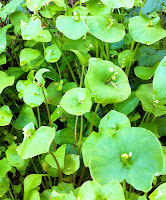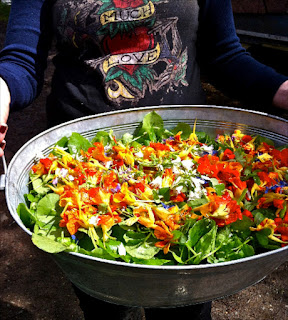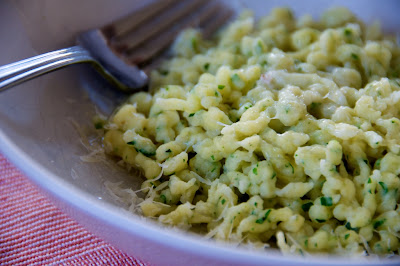West Marin at the end of March is a trip into Eden. The headlands have greened up from winter rains (admittedly spotty this year), the rivers run high, and the woods and meadows overflow with a riot of tangled undergrowth, much of it edible.
More than 20 years ago, when I lived briefly in Berkeley and San Francisco, I heard stories about Bolinas. Tucked away on a thumb of land south of Pt. Reyes and between the Pacific Ocean and Bolinas Lagoon, the community shunned conventional ways. The funny-looking locals farmed funny-looking crops in funny ways. Heck, maybe they even foraged (gasp!). This led to busloads of tourists wanting pictures of the native wildlife. Whenever the county erected a sign tipping off lookey-loos to their whereabouts, the locals tore it down. There’s still no sign today, but the tenets of organic farming that began largely in this valley are now practiced all over the country; local artisan food makers are celebrated across the land for their award-winning breads, brews, cheeses, meats, and preserves; and foraging is just another common sense way to gather fresh, healthy food.
This past weekend, thanks to organizer Marin Organic, I joined with a few dozen food and outdoor lovers from all over the Bay to wander among the stunning beauty and bounty of Bolinas. [Listen to a radio story about the event here.] Kevin Feinstein, co-author of The Bay Area Forager, was on hand to share his local wisdom, and we were fortunate to have a few practicing chefs (plus eager students) to help with the afternoon feast. The weather looked ominous. Driving over Mount Tam, my rental car shook violently in the wind. Rain blowing in off the Pacific slashed sideways at my windshield. But by the time we poked our heads out from under the eaves of the Gospel Flat Farm stand, the rain had subsided and the sun was working hard to shoehorn clouds out the way.
We all walked across the street to the Star Route Farms property that would be our primary hunting ground. Normally I wouldn’t be enthusiastic about picking wild foods next to a farm, but Star Route has been organic for nearly four decades, and it shows. The rows between crops are loaded with weeds—healthy, nutritious, delicious weeds—weeds that get harvested right along with the domestic vegetables. [See top photo.] We picked nasturtium flowers, wild radish seed pods, mallow, cat’s ear, and other weeds before climbing up into the wet jungle that rises above the farm, protecting its watershed with a forest of native trees and a host of native and non-native edible plants.

Robust patches of miner’s lettuce forced us to choose our steps carefully lest we trample a good food source. The stinging nettles were tall, nearly too tall for harvest, so we snipped the tops of the youngest, tenderest plants. Chickweed flourished among the miner’s lettuce. Huge thickets of thimbleberry, already budding out, towered above us on the hillside, and red elderberry in flower hung overhead. It was an orgy of wild foods. Kevin pulled a few thistles from the damp soil and demonstrated how to peel the lower stalk and boil the root (note to self: I really need to do a dedicated thistle post one of these days).
 |
| Andrea Blum Photo |
Back at Gospel Flat we turned our attention to processing and cooking our catch. Everyone happily pitched in. The wine flowed. Kevin prepared a taste test of thistles, both raw and cooked, while the rest of us worked on the three main dishes of the day: oysters, soup, and salad. An appetizer of pan-fried oysters donated by Tomales Bay Oyster Company, dressed with a homemade aioli (thanks Kerry!) on Brick Maiden Bakery baguette, was devoured on the spot. Next came an enormous salad of miner’s lettuce, chickweed, cat’s ear, mallow, nasturtiums, wild onion, wild mustard flowers, and wild radish seed pods that filled an entire wash basin. Toasted walnuts, crumbled blue cheese from Point Reyes Farmstead Cheese, and a raspberry vinaigrette added finishing touches to the salad.
Meanwhile several volunteers chopped onions and garlic, peeled potatoes, and tended three kettles of Stinging Nettle Soup cooking on a propane stove on the back porch. Despite the early rain showers, the day was just getting better with each passing hour. We added a hearty pour of Straus Family cream to the soup and had at it.
Nothing beats tromping around in the woods in search of strange and often maligned plants and then transforming them into culinary marvels amidst a hubbub of wine and cheerful conversation. Coming together to nourish our minds and bodies was the order of the day. These are the basic underlying principles of community.
Foraging is often seen as a survival skill, a way for the individual to go it alone in a harsh environment and still prosper. Though I value my alone time for art, contemplation, spiritual renewal, or any number of other things—and have indulged this solitary life for months at a time in the wilderness—at the end of the day I would never renounce my need or desire to be among other people, to share in ideas and joys, to participate in the human drama. For me, foraging is not a path to isolation—it’s a way to connect.
I’ve been supremely disappointed in our U.S. Supreme Court in recent years as it seems to thumb its judicial nose at the very concept of community in America, as if liberty can only be defined as the individual giving the finger to everyone else. Clearly, since our institutions are failing us, it’s up to us, the people, to create community—and to hold onto it dearly.
Like this:
Like Loading...











